Eucalyptus trees growing high in the Andes Mountains? Shortly after arriving in Cusco, Peru, I was astonished to see groves of these native Australian trees at elevations greater than 10,000 feet (3,048 m). The value of the trees soon became clear, however, as I wandered through an open-air marketplace. Each of the merchandise stalls had corner and roof beams holding tarps that were assembled with spindly but strong eucalyptus timbers. I had conflicted feelings about finding eucalyptus in Peru. Although I realized this could bring benefits to the local population, I also knew the trees can bring ecological damage.
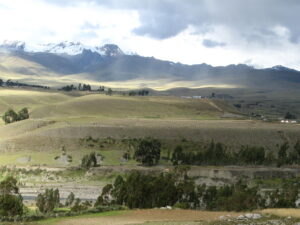
Eucalyptus near Huaraz, Peru; elevation about 10,000 ft (3,048 m)
Eucalyptus trees are never out of sight for long where I live in the San Francisco Bay Area. They are the most widely planted non-native trees in the state, introduced from Australia to California in the 1850s during the Gold Rush. Importers hoped the trees would provide a needed source of railroad ties and lumber for construction. When young trees are harvested, however, they have a tendency to split or warp—so the high hopes for this new industry died quickly. Instead, the stately trees have valuable uses for windbreaks, as shade and ornamental trees, and for firewood. They also drive out native species, and they are extremely flammable, so their spread is controversial.
Coastal California has a Mediterranean-type climate that is like that found in parts of Australia, so it isn’t surprising that eucalyptus thrives. Finding eucalyptus at high elevations in the Peruvian Andes, however, made me curious about why and when people introduced these trees. It is an interesting story.
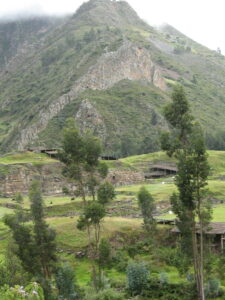
Eucalyptus growing near the archaeological site of Chavin de Huantar, Peru; elevation 10,430 ft (3,180 m)
What Ancient Andeans Saw
Peru is in the central part of the Andes Mountains chain, the longest mountain range on Earth. For thousands of years, the region encompassing Peru and adjoining countries was the homeland of ancient societies that culminated in the Inca Empire. Today, the approximately 4,000 mi (6,440 km) length of the Andes Mountains spans more vegetation types than anywhere else, extending from sea level along the Pacific coast up to around 15,000 feet elevation in altitudinal zones. When the ancient Andeans began carving out a living in the highlands, the region had tremendous plant diversity. A corresponding range of growing conditions allowed a variety of agricultural crops to be grown, and this became a major factor in the tremendous achievements of ancient Andean cultures.
Plant pollen is a valuable tool for unraveling the history of a landscape. Lake sediments where cores have been drilled and analyzed reveal the millennia-long spread of agricultural crops and the reduction of native vegetation. Over the thousands of years that ancient societies thrived at the high elevations of the Andes, people harvested plants for construction material, firewood, charcoal production, and other uses. Many areas were burned and cleared to create pastures for grazing llamas and alpacas. (Learn more about the geography and ancient cultures of the Central Andes in The Monumental Andes, my book that will be available early in 2024.)
Gnarled trees and shrubs, members of the rose family belonging to the Polylepis genus, are endemic to the mid- and high-elevation regions of the Peruvian Andes and highly adapted to harsh conditions. Some species form woodlands at even the extremely high elevations of around 16,000 ft (5,000 m). Historical accounts about the Incas indicate that Polylepis trees were greatly valued, and these and other native species were planted to fill needs for fuel and timber. After Spanish conquistadores arrived in 1532, however, the newcomers lost no time in exploiting the riches of their newly conquered lands. Many regions were rapidly deforested, with the timber used for fuel and construction, including scaffolding in underground gold and silver mines. Introduced cattle, sheep, and other domestic grazing animals trampled other extensive areas of native vegetation. Within decades, mountains and valleys were bare, with Polylepis stragglers surviving, usually on steep slopes. (Happily, I had the opportunity to see these trees in protected areas of the Cordillera Blanca in northern Peru.)
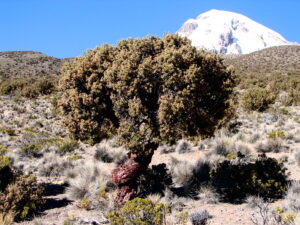
Polylepis trees that grow in the Andes highland region of Peru, Bolivia and Chile are one of the highest altitude living trees in the world. This image of the tree was taken at 16,000 ft (4875 m) above sea level in Bolivia. (Wikipedia)
More than a century ago, eucalyptus was introduced in the Peruvian Andes, but the trees did not become prominent features of the landscape until the 1960s under agrarian reforms. As part of this reorganization, the state redistributed large tracts of land into cooperatives controlled by highland farmers and promoted the cultivation of eucalyptus. Government officials hoped the trees would provide impoverished rural people with a source of fuel, building materials, and possibly a commodity to export to urban centers and even foreign markets. When government investments in reforestation diminished in the 1980s, private enterprises and NGOs became involved, and established vast areas of eucalyptus and non-native but fast-growing pine species in plantations. There have been many economic and cultural benefits from these new forests, but also negative effects.
A Few Facts About Eucalyptus
The Eucalyptus globulus forests that dominate many Peruvian hillsides are a variety commonly known as Tasmanian blue gum and native to southeastern Australia. This species of eucalyptus grows rapidly and is adaptable to a range of conditions, including those at high altitudes in tropical regions like Peru and the adjoining tropical latitudes of the Andes. The trees typically grow to heights of about 100 to 180 feet (30 to 55 m).
Almost all the over 700 species of eucalyptus are native to Australia and the surrounding islands of Southeast Asia. European collectors first encountered the trees while traveling with explorers in the late 1700s. Today, they are cultivated throughout the tropical and temperate world, where they are valued for fast growth tendencies and a variety of economic uses. Over 100 countries across six continents have planted these nonnative trees, making eucalyptus the most widely planted broad-leaved tree species on the planet.
The trees have some unusual characteristics. Each year, eucalyptus adds a new layer of bark when the outermost layer dies, eventually to be shed. In some varieties, including E. globulus, bark cells can photosynthesize in the absence of foliage, allowing the tree to grow in a wider variety of climates, as well as to recover from damage in an event such as a fire. Deep or prolonged freezes can kill them, but they can sprout fresh growth from the roots, trunk, or large branches. Leaves produce copious amounts of oil, giving the trees a pungent, camphor-like fragrance. A steam distillation process is used to extract the oils, which are used in antiseptics, cleaning products, insect repellants, flavorings and fragrances, and pharmaceuticals. Wood is useful for poles and fence posts, to make charcoal, and in manufactured products, including for particle boards and pulp for paper.
There are also disadvantages to these trees. The rapid growth and high rates of transpiration mean the trees draw up massive amounts of water and soil nutrients. Oils in eucalyptus leaves contain compounds that are toxic to many plants and animals, so they out-compete rival plants, which are typically the natives. (In California, eucalyptus groves have replaced many oak woodlands.) Oils reach waterways, where the increased acidity can threaten animal life. The absence of plants in undergrowth means hillsides are more susceptible to erosion.
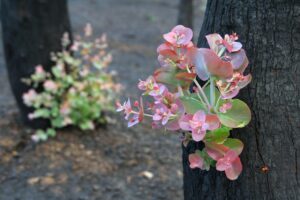
New growth sprouting from eucalyptus four months after the 2009 Black Saturday bushfires in Victoria, southeast Australia (Wikipedia)
Fueling Fires
An additional big disadvantage of eucalyptus: they are extremely flammable. Whether the genus evolved to survive fires, or whether they developed characteristics that actually promote it to snuff out competitors, is unclear. Interestingly, Aboriginal people likely increased the spread of these trees through their use of small fires for hunting and maintaining habitat conditions suitable for animals. Humans colonized modern Australia tens of thousands of years ago, and sediment studies show a corresponding and dramatic increase in the abundance of eucalyptus pollen that is also associated with a rise in the levels of charcoal. Changes in fire management over the past few centuries contribute to the devastating wildfires in Australia that are fueled by abundant eucalyptus.
Characteristics of eucalypts that contribute to fires include the highly flammable oil in the leaves. These vapors have the dubious distinction of exploding in a fire, allowing sparks to travel easily through tree crowns. The winds of fires can carry peeling bark aloft, also effectively spreading blazes. Beneath the trees, large amounts of leaf litter and bark accumulate as dry and combustible fuel, promoting catastrophic firestorms. Many species of eucalyptus rely on fires to open their seed pods. The thick bark protects the trees, and even if they are destroyed, they re-sprout by sending up fresh shoots from specialized organs in the roots or from buds deep in the bark.
Eucalyptus in the North Oakland and Berkeley hills, above where I have lived for decades, were a major contributor to an October 19-20, 1991, firestorm. I was an anxious and first-hand witness to this fire, which spread on a hot and extremely windy Sunday morning. Once the first flames appeared on the ridge above my home, we could stand on the roof and watch for hours as lines of eucalyptus trees and gas-filled houses exploded, one after another, and the fire crept downhill towards the flatlands. (At the peak of the firestorm, one house was reportedly destroyed every 11 seconds.) The advancing fire filled the air with smoke and ash, along with the sounds of sirens and aircraft dumping fire retardants. Late in the day, the wind stopped fortuitously, or the fire probably would have burned until it reached San Francisco Bay. Nonetheless, 25 people died, and nearly 3000 houses, along with hundreds of other dwelling units, were destroyed over an area of about 1,520 acres (6210 ha).
Eucalyptus in South America
Peru is only one of several South American countries with large tracts of eucalyptus. Brazil reportedly has the largest proportion of eucalyptus plantations in the world (22%). Other South American countries have extensive areas of these trees, although they are lower on the list, including Uruguay (3%), Chile (3%), and Peru (2%). While planting eucalyptus trees provides economic benefits for some, establishing plantations often leads to other social disruptions, including displacing indigenous people.
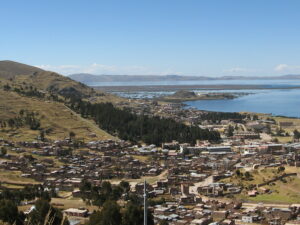
Eucalyptus trees in Puno, Peru, elevation 12,556 ft (3,830 m) with Lake Titicaca in the background
In the high Andes, climate change and a decrease in water availability are serious issues facing populations. Temperatures are rising, glaciers are melting at accelerated rates, and significant reductions in glacier mass are underway, lowering water supplies that are essential to support people, agriculture, and ecosystems. Researchers who have analyzed the effects on water availability for eucalyptus plantations show that on many parts of the continent, water deficits will soon make growing these trees economically unfeasible.
Currently in the Peruvian Andes, eucalyptus trees are important contributors to local and regional economies and have helped to ease poverty. These impacts are difficult to quantify, however, since much of the production, consumption, and marketing of eucalyptus timber products is outside of the formal economy. Although forest plantations have obvious benefits, they are also controversial because of adverse effects on biodiversity, hydrology, and soil fertility. Our world is a complex place.
If you liked this post, please share it and/or leave a comment or question below and I will reply – thanks! And if you’d like to receive a message when I publish a new post, scroll down to the bottom of this page, and leave your email address on my website. Join now to learn more about geology, geography, culture, and history.
SOURCES
Chepstow-Lusty, A. and Jonsson, P., 2000. Inca agroforestry: lessons from the past. AMBIO: A Journal of the Human Environment, 29(6), pp.322-328.
Luzar, J., 2007. The political ecology of a “forest transition”: Eucalyptus forestry in the southern Peruvian Andes. Ethnobotany Research & Applications, pp.85-93.
Martins, F.B., Benassi, R.B., Torres, R.R. and de Brito Neto, F.A., 2022. Impacts of 1.5 C and 2 C global warming on Eucalyptus plantations in South America. Science of The Total Environment, 825, p.153820.
Seng Hua, L., Wei Chen, L., Antov, P., Kristak, L. and Md Tahir, P., 2022. Engineering wood products from Eucalyptus spp. Advances in Materials Science and Engineering, 2022, pp.1-14.
St. George, Z., 2016. The burning question in the East Bay Hills: eucalyptus is flammable compared to what? Bay Nature magazine, October-December.
Photo of Polylepis rugulosa that belongs to the genus Polylepis, trees that grow in the Andes highland region of Peru, Bolivia and Chile. It is one of the highest altitude living trees in the world. This image of the tree was taken at 4875 m (16,000 feet) above sea level on the slopes of Sajama National Park in Bolivia, 2006, by Alexander Yates. https://en.wikipedia.org/wiki/Polylepis#/media/File:Polylepis_rugulosa_(A._Yates).jpg
Photo of epicormic regrowth from bark of eucalypt, four months after Black Saturday bushfires, Strathewen, Victoria, June 2009, by Robert Kerton, CSIRO.
Photos of Peru, 2009, by the author.

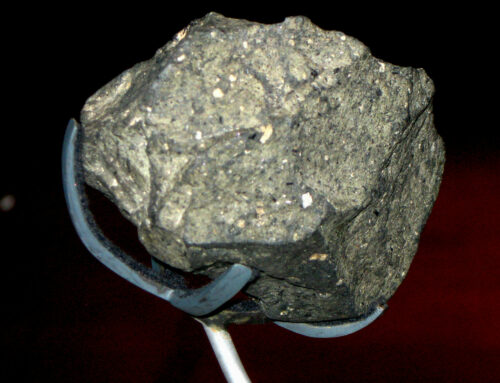
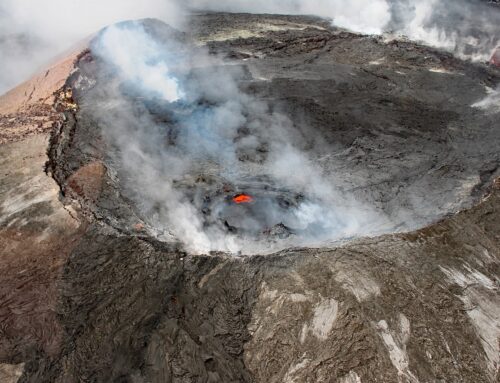
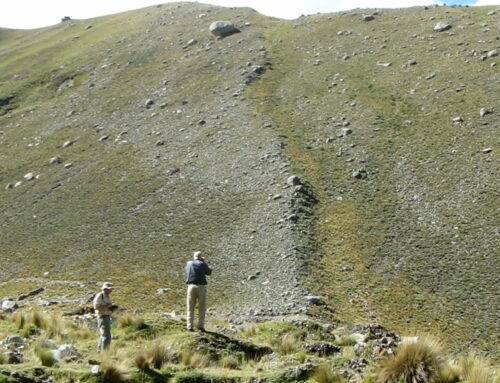


And I thought you were only a geologist!
When I visited Ecuador recently, in the area of the Cotopaxi volcano at 3200m, they are everywhere and I too wondered about their presence.
One would think they had been there forever since are so well adapted. Fires do not seem to be a problem since a lower O2 partial pressure prevents combustion.
They make for fabukous hikes with their smell and the shade they provide.
Thanks, Leo! Interesting that you saw so many eucalyptus in Ecuador. Good point about a lower O2 partial pressure — plus temperatures are cooler at high elevations, also limiting the fire risks.
I might add, that to those of us who live among our neighbors’ eucalyptus trees, the smell is not inviting, but rather fear inducing.
Btw, Portugal has vast forests of eucs that led to the devastating fires of 2021. They are a menace.
Thanks, Steve. I agree that in many areas the trees should be replaced — they are just too hazardous.
Roseanne, I don’t recall whether or not I left my message. Rachel lives in Santa Barbara, CA which is filled with many eucalyptus trees. I’ve been told the trees were planted for railroad ties and it has been implied that the species is not a totally beneficial. They are beautiful to me because they signal I am visiting my daughter. Thank you, again, for an educational and well written post.
Karen
Thanks, Karen — I appreciate your comment!
The story of Eucalyptus as I’ve heard it expands on what @Karen said above.
In the early 1900s, there was fear of wood shortages in the US. Farmers who had grown it for windrows were impressed by how quickly it grew. These casual reports were amplified by people selling Eucalyptus seedlings – it was touted as a miracle wood.
The United States Department of Agriculture’s Forestry Service had already warned that its wood could not be harvested economically. But that didn’t stop decades of hucksters from advertising that farmers should convert their productive farmlands into Eucalyptus groves. Nor did it prevent people who needed wood from listening to those hucksters. The most notable victims of the Eucalyptus hoax were railroad companies, who dedicated their vast tracts of land – granted by the US government as economic compensation to build railroads – to the cultivation of lumber for the sleepers needef by their trains, as well as lumber for the cities they imagined would spread from their railroad stations.
The USDA proceeded to publish (Tiemann 1913) a comprehensive review of the harvesting and curing of eucalyptus which demonstrated unambiguously that the wood was unsuitable for producing board wood. Harvest young and it warps; harvest old and it’s so hard that it ruins your saws.
But the seeds had already been planted, in the US and around the world.
Later optimism about new techniques for conditioning led to new eucalyptus lumber booms, but to my knowledge they’ve all been busts in the end. Eucalyptus functions effectively for shade from sun and wind, but little else.
Thank you for this comment and the information — very interesting.